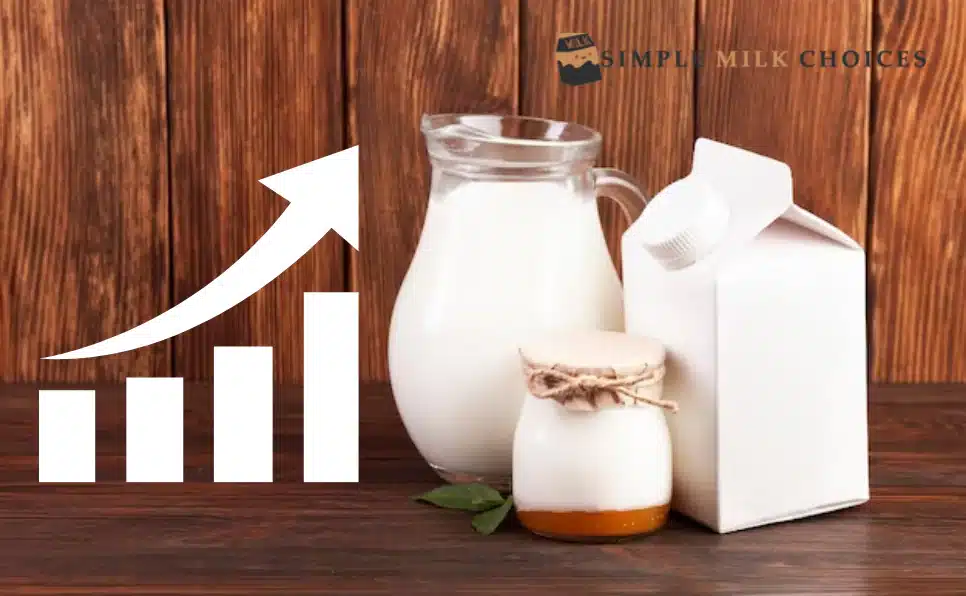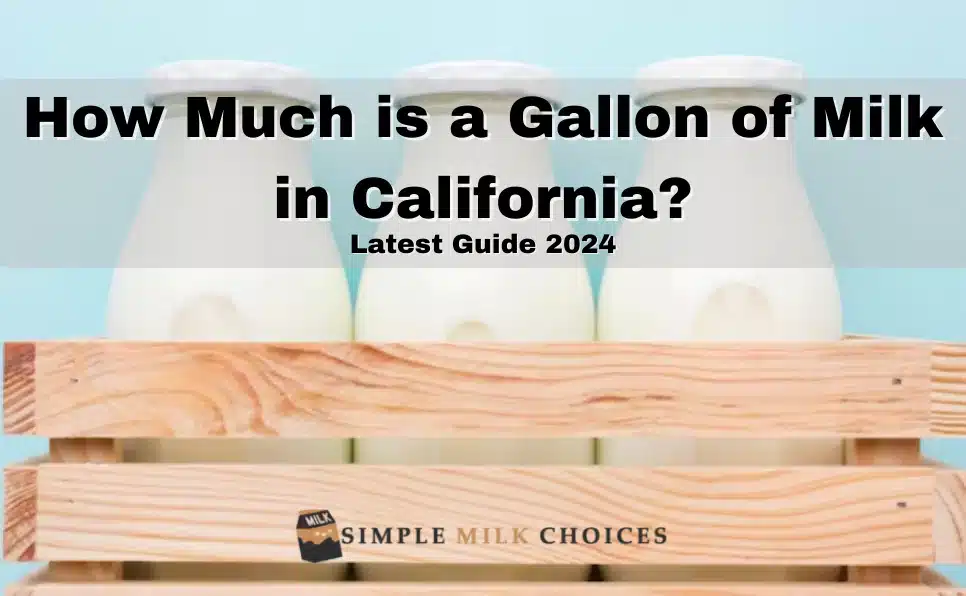Suppose you are walking through a grocery store in California. You’re pushing a cart and filling it with everything you need. It’s all your essentials, right there in your cart. You reach the dairy section. And stop there. You start looking at the rows of milk cartons. Out of the blue, you start wondering: How much does a gallon of milk cost in California? The question pops up in your mind. You want to know the price of a gallon of milk in California, right?
So grab a seat, because that’s precisely what this blog post will be all about. We’re not just talking numbers here; we’re going to take a look at the story behind the price tag. So, grab a snack and settle in as we resolve the mystery of the cost of a gallon of milk in the Golden State.
In this thriving position of innovation and diversity, everyday expenses like groceries can sometimes raise eyebrows. But don’t worry, residents of California (and curious minds everywhere). Our journey isn’t just about the price you pay at the register. It’s about the journey of that milk from farm to fridge and the various factors that influence its cost.
Before composing this article, we had previously covered the prices of a gallon of milk in various states, including Hawaii and Alaska. Therefore, you can rest assured that the information provided here will be accurate, authentic, and supported by potential references.
Economics and Impact Behind a Gallon of Milk in California
In this exploration, we’ll navigate through the economic landscape, understanding the consequences of factors such as production costs, distribution logistics, market demands, and even environmental impacts. From the sprawling dairy farms to the bustling cities, each step in the process plays a role in determining that final price tag.
So, why should you care about the cost of a gallon of milk? Understanding these details helps us see why our grocery bill is the way it is. It shows how our daily lives connect with both the economy and the environment. This understanding gives us a bigger picture.
This blog post isn’t just about numbers; it’s about the story behind those numbers—the story of a staple item that graces countless kitchen tables, a story that impacts both producers and consumers alike. So, let’s start this journey together and explore the secrets behind that gallon of milk in California.
Understanding the Overall Cost of Milk
Let’s roll up our sleeves and look into the main topic: understanding the cost of milk in California. It’s not just a number—it’s the culmination of several moving parts that determine what you pay at the checkout counter.
Firstly, production costs play a pivotal role.
Production Cost
Farmers try to provide for their cows. They see to it that the cows are healthy and fed properly. They also maintain the facilities used for producing milk. These expenses, along with overhead costs like labor and equipment, contribute significantly to the final price of that gallon of milk.
But hold on, there’s more to the story. Transportation is another big player in this game.
Transportation
Milk travels a long way from the big dairy farms. It goes all the way to the local grocery stores. The journey of milk covers quite a distance. Fuel prices, vehicle maintenance, and even distance traveled—all these elements add their value to the total cost of a gallon of milk.
In this mix, market competition acts like spice, making prices go up when there’s more demand than supply. This role mirrors economics, where increased demand surpassing supply leads to price hikes. Conversely, a surplus of milk flooding the market might cause prices to dip as producers compete for attention and sales.
Supply and demand work like magical forces. They control how milk prices go up and down. These dynamics determine the changes in milk prices. During holidays or special events, lots of people wanting something all at once can make prices go up. Prices can inch upward when there’s suddenly a big demand for something. A surge in how much people want something, like during the holidays, can push prices higher. Conversely, a surplus in milk production might lead to a drop in prices as producers aim to clear shelves.
Understanding these economic dynamics behind that humble gallon of milk not only sheds light on why prices fluctuate but also highlights the intricate dance between production, distribution, and consumer demand.
Stay tuned as we go more deeply into this economic orchestra and uncover more layers behind the cost of a gallon of milk in California. It’s not just about the money—it’s about the interconnected web of factors shaping something as seemingly simple as your morning cereal’s best companion.

Historical Trends in Milk Prices
Let’s go back in time and examine the historical trends in California milk prices. It’s like comparing through a time machine to understand how the cost of a gallon of milk has evolved over the past decade.
Looking into the data archives, we discover a fascinating story. The price of milk went up and down a lot over the years. Many things affected how much it cost. Since 2010, the numbers have exhibited fluctuations, reflecting changes in the economy, consumer spending habits, and shifts in industries. These changes have impacted the numbers, causing them to move in various directions. The fluctuations in the numbers illustrate the changes over time in aspects such as finances, consumer preferences, and business operations.
There have been moments of stability where prices held steady, providing a comforting consistency for consumers. But then, there have been spikes and dips in milk prices, just like a rollercoaster ride. These changes often happened because production shifted, demand changed, or external factors affected the dairy industry.
However, the concern is: What are the prices of a gallon of milk in California right now?
Stay tuned with us as we continue to explore the story behind the cost of a gallon of milk in California, exploring not just the present but also learning from the footsteps of the past. Because sometimes, understanding where we’ve been helps us navigate where we’re going.

The Current Price of a Gallon of Milk in California
Let’s start looking into the current landscape of milk prices in California. By conducting market research across local grocery stores and supermarkets, we’ve gathered the latest statistics on the price of a gallon of milk.
Attention here, please! As of now, the current price of a gallon of milk in California continues to range from $4.15 to $4.90 (source). But hold onto your hats; this price can vary across different regions of the state.
In some places, the average cost could be lower. In other areas, it could be closer to a higher price. The cost varies depending on the location. As discussed earlier in the article, factors such as production, distribution, and local demand shape this range. Californians experience diverse milk prices based on where they shop. These factors contribute to variations in the amount people pay for milk.
The dairy market in California is always changing. Competition, transportation costs, and regional preferences affect the price range. These factors shape how much you pay for a gallon of milk that you trust.
What is the Expected Price of a Gallon of Milk in California in 2024?
We want to peek ahead and see what might happen with milk prices in California. The predictions hint at prices going up, maybe reaching $4.25 to $5 for a gallon. These guesses aren’t precise, but they give us an idea of what could happen.
The predicted changes can change; they’re not definite. We make these predictions by looking at trends and watching how the market moves. We try to guess how different things might work together in the future.
Right now, we happily buy our reliable gallon of milk. The price usually falls between $4.15 and $4.90. It’s important to watch for any changes in the future. The ever-evolving dynamics of California’s dairy market might influence the price tag. The future could bring a slightly different price. These changes are because the market keeps changing all the time.
Conclusion
In conclusion, the price of a gallon of milk in California isn’t as fixed as it looks. Presently, it ranges between $4.15 and $4.90, but the future might bring a shift, predicted to potentially reach $4.25 to $5. These figures are like hints to a mystery, showing us how the dairy market can change.
Production, demand, and industry shifts actively shape milk prices. Understanding these influences is crucial. It helps us comprehend how the cost of a gallon of milk changes dynamically. So, keep an eye on the horizon—the dairy market’s journey never stops evolving.





